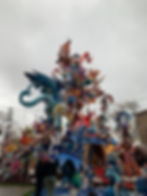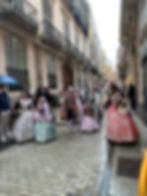By: Callie Schaden |

At the very center of my study abroad experience in Valencia, Spain sat Las Fallas, a festival about which I knew absolutely nothing, but the entire city seemed to be restlessly anticipating. As a student of the Spanish language and the Spanish culture, I was taking things in in chunks. Valencia was buzzing excitedly around me, signs of Las Fallas popping up every few days, but I had no basis for cultural context and I couldn’t quite yet understand the passing conversations on the street, so I learned by experience.
My introduction to Las Fallas started on February 27th with an “if it’s too crowded I’ll just stand in the back”. My roommates and I walked a mile and a half from our apartment to the Torres de Serranos, but it only took me about a mile to realize that “standing in the back” was far from an option. This first night at the Torres de Serranos is the kickoff to the three-week celebration that is Las Fallas, and the streets surrounding the Torres were flooded with people in all directions. There were even people hanging out of the balconies of the pisos, apartments, as far as I could see. Now, I am from a small town in Ohio and had only been in Valencia for just over a month, so this perspective of the city had me shelling layers of culture shock I didn’t even know existed. Being in a new country is one thing, and for me, being in a city was another thing, but the amount of people was a whole new level of experience. And, turns out, this seemingly endless ocean of people could hardly be considered an ocean in comparison to the crowds that the next three weeks continued to draw. Just when I thought I was getting comfortable with my life in Spain, Las Fallas introduced me up-close and personal to true Valencian culture and tradition. So here’s Las Fallas in a nutshell—a history lesson as told by my professor Carlos, a quick run-down on what to expect, and some inside observations from an outsider looking in.

Images: Callie Schaden, “Ninots before La Cremà”, 2022
I didn’t get to take any official history classes during my time in Spain, but luckily my grammar and translation professor was a wealth of knowledge and random facts. Here’s his SparkNotes version of the history of Las Fallas: Las Fallas was born out of the carpenters’ spring cleaning their talleres, workshops, once a year on the Día de San José. They would pile up all the leftover scraps of wood and burn them in the street. Gradually it became a tradition to build the scraps into figures or scenes before burning them. The carpinteros, carpenters, would compete to see who could build the best one, some even adding strips of cloth as clothing. Eventually this tradition became what ninots are today: Each barrio builds their own figures, ninots, from plaster, wood, papier mache, or cardboard. Now they are extremely lifelike and satirical, often depicting social and cultural events as a form of critique. They resemble the caricature art style and can be multiple stories tall. The burning of the ninots happens on the last night of Fallas, March 19th, Día de San José, called La Cremà in Valenciano (“the burning”). These fires are the main event, with crowds so thick that walking is nearly impossible the closer you get to each ninot. My roommates and I ran up and down Valencia waiting for each one to go up in grand flames, black smoke swirling over the tops of the palm trees, glittering golden ashes floating to the ground. These ninots burn incredibly fast. A short firework show announces the start of each fire and then the flames crawl up from the base, engulfing the whole figure until the shape crumbles into ashes.

Images: Callie Schaden, “Burning Ninots”, 2022
After that very first night at the Torres de Serranos, life seemed to commence as normal for the next two weeks, but the whole city felt more alive and excited. Everything was building up to La Cremà. Little glimmers of Las Fallas started to appear around the city: pop-up churrerías in every plaza, more colorful neighborhood lights, and falleros and falleras—boys and girls dressed in traditional Spanish clothing—parading through the streets. As the third week of Fallas approached, intersections were completely closed off and ninots wrapped in plastic were trucked in from their hiding spots in pieces to be assembled throughout the week. Valencia is already a walking city, but during Las Fallas, even those who habitually drove had to ditch their cars for pedestrian travel. Despite the slow and steady buildup of Fallas action, there was one thing that served as a constant reminder that we were in the midst of Las Fallas: the fireworks.
I grew quickly accustomed to the round-the-clock sounds of petardos—firecrackers—exploding on the sidewalks and in the plazas, and the much louder booms of what are also called “petardos”, but are most definitely not firecrackers. These are only legal during Las Fallas, and, based on my observations, are the kids’ favorite part. It is not uncommon to pass kids on the street clutching a wooden box hung from their neck by a piece of string or even just tucked under their arm. Here’s a tip: make a wide circle around any kids huddled up around a wooden box or hiding in a corner, because tirar petardos—throwing firecrackers—to scare innocent passersby is perhaps an unspoken element of the Fallas tradition. The noise during these three weeks is so constant that people even send their dogs away to stay with relatives in the country where it’s more peaceful.
However, petardos are not the only kind of fireworks that characterize Valencia during Las Fallas. One of the main events of Las Fallas is called the mascletà and it happens every day at 2pm in the Plaza del Ayuntamiento. It is a display of fireworks that doesn’t include light or color, but is instead centered on loud, rhythmic sounds. I really did not understand the draw of the mascletà at first, but then one day I arrived in person at the Plaza del Ayuntamiento. Yet again, I was amazed by the size of the crowd that gathered—so big that the streets were thick with people even half a mile away. We were an hour early to this event that happened daily and lasted no more than five minutes, and we still could not get near the front of the crowd. Like any fireworks show, the mascletà starts slowly and builds up to a grand finale, but the rhythm and the volume are the most important components. Each day a different pyrotechnic is in charge of designing the mascletà, so each day is new and different, but what remains the same is the unearthly feeling of the fireworks rumbling under your feet and pounding in your chest while all the sound around you is drowned out by the noise of the explosions. Even the smoke is an incredible sight to see, pooling into the air so thick that after a few minutes, the tops of the buildings have been swallowed up by heavy grey clouds. I only saw the mascletà in person twice, but each time I felt myself embracing the Valencian love for the noise and the rumbling in my chest.

Images: Callie Schaden, “Falleras in Parade”, 2022
Being in Valencia during these three weeks will, if nothing else, keep you on your toes. Just when I was feeling like I understood the rhythm of Las Fallas, I woke up in the middle of the night to booming club music. We lived in a quieter, calmer barrio so this was not an occurrence that made any sense to me, even with all the activity going on. This was my introduction to verbenas. I learned from my host mom the next morning that each barrio has its own tent for the falleras and falleros which is used for a number of things throughout the last week of Las Fallas, but most famously—verbenas. To an outsider like me, in the process of learning the language and the social cues, these parties seemed super exclusive. Big men stood outside of the doors and waited for you to prove you were invited by a fallera in order to get in. One night my roommate and I went to a verbena in the barrio of one of our friends because her host sister was a fallera. When we left at 4am, the party hadn’t gotten any smaller. These last few days of Las Fallas seemed to be when all the action happened. Aside from verbenas, there were parades of falleros and falleras, enormous fireworks displays called castillos every night after midnight, and people, always people out in the streets laughing and talking and celebrating.
Las Fallas was a creative way to strip a small-town country girl of her expectations for life in the bustling city of Valencia. Although the city always felt so awake to me, it was a thousand times more alive during Las Fallas. The excitement was invisible but contagious. It introduced me to a side of the culture that beams with pride for its Valencian roots and interrupts the routine of daily life for a celebration that involves all ages. I experienced Las Fallas surprise after surprise after surprise, each new element pulling me deeper into Valencia’s rich culture, helping me learn not through words, but through a unique and vibrant tradition.
Book a language class with ILC!
We have classes in any world language with online, in-person and hybrid options. Send a DM, email us at: info@indylanguagecenter.com, or simply call 844 503 1237 for more info.
Callie Schaden is currently an English and Spanish student at Cedarville University. She grew up in a small town in Ohio and has expanded her horizons in El Salvador and Valencia, Spain, two places which have given her a love for the Spanish language and a desire to continue learning outside of her native tongue.
